|
Boris Karloff is one of those actors I could happily watch performing in anything, but even today after literally hundreds of film and TV roles, he’s still known primarily for just a handful of them. It’s because of this perception of him as an actor who always played the monster that he was able to so successfully send the image up in the original stage production of Arsenic and Old Lace, where he played a criminal whose face had been altered by a plastic surgeon and complained to the delight of Broadway audiences that he now looked like Boris Karloff.
As is pointed out in one of the commentaries in this collection, the six films Karloff made for Columbia tend to get overlooked in the critical discussion of horror films from this period, although the case is also made for not seeing these as horror works at all. The first of them is more a gothic melodrama, the next four have a science fiction leaning and the last is a comic riff on the formula at the heart of the previous four movies, rounding off what became known as Karloff’s ‘Mad Doctor’ series.
I’ll admit that I’d seen none of the films in this set until I sat down to watch these discs, and while my original intention was to keep my coverage of the individual films brief, I enjoyed them too much to just scribble a few words about each title and move on. So, buckle up, because this is going to be a long one, as we delve into the wonderful world of Karloff at Columbia.
In late eighteenth century Austria, the Baron Frederick de Berghman (Henry Kolker) is informed that his wife has just given birth to twin boys. Instead of whooping with joy, he treats this news as a prophecy of doom. History tells that his family began with the birth of twin boys, the older of whom was later murdered by his minute-younger brother in a quarter of the house known as the Black Room, and legend has it that the family will end the same way. The younger and more rational Lt. Paul Hassel (Colin Tapley) refuses to believe there could be anything in such a prophecy, but the Baron is not to be dissuaded and remains convinced that jealousy over the title and lands that the older brother will inherit will eventually drive his younger sibling to kill him in the Black Room as predicted. “The younger will have greater reason than that for bitterness, my Lord,” pipes up the doctor unhelpfully at this moment and reveals that the younger boy’s right arm is paralysed. It’s the level-headed Hassel who proposes a logical way to prevent events unfolding as predicted when he suggests that the Baron have the Black Room walled up, a suggestion that is promptly acted upon. Yeah, that should do it.
Years later, the Baron and his wife have passed on and the two boys have grown into men. The older brother, Gregor (Boris Karloff), is now the Baron and is disliked and distrusted by the local populace, while his more sensitive brother, Anton (also Karloff), has moved to Budapest to escape Gregor’s lingering belief that his younger brother will one day turn on him and kill him. Now Anton is returning to the family home in response to a plea from Gregor, unaware that his brother has a diabolical plan to both protect himself from the rising hatred of the local peasantry and win the hand of Thea Hassel (Marian Marsh), the pretty daughter of the now middle-aged Paul.
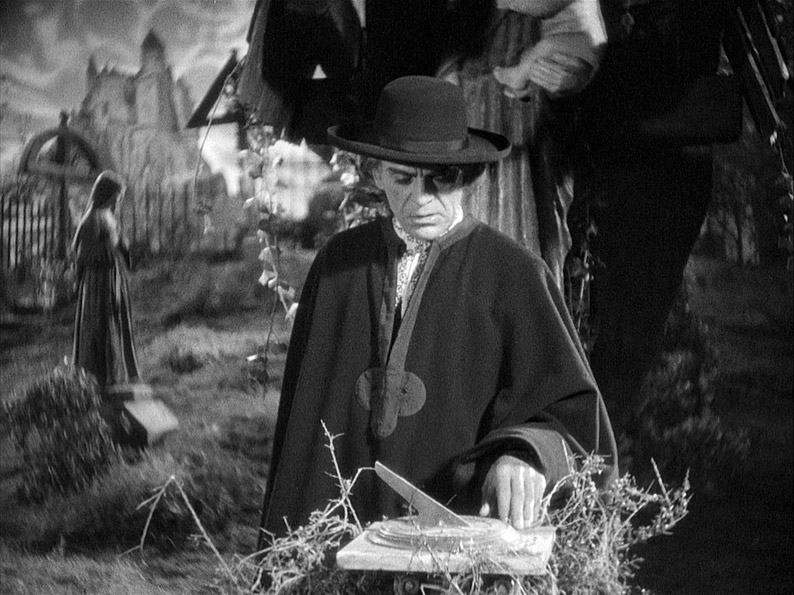
It very quickly becomes clear that The Black Room is not some low-budget quickie made to cash in on the rising popularity of its star. For a start, it looks lovely, with Stephen Goossen’s art direction – which is impressive enough inside of the Baron’s castle – going into gothic overdrive in the family graveyard, where generations of de Berghmans appear to have competed to see who can have the more elaborate or more religiously significant grave marker. Complimenting it at every turn is Allen G. Siegler’s gorgeous monochrome cinematography, which shines in its atmospheric lighting, its purposeful and creative framing and its occasionally striking angles. On top of that, the techniques employed by Siegler twice had me convinced that I was watching a considerably more recent work. The first comes when Gregor leads Anton into the Black Room though a secret fireplace entrance and he is lit primarily by the candle he is carrying. Now the standard method of doing this in films of this period was to shine a small spotlight on the carrier and follow them as they move. Yet here the light is clearly hidden inside the candle itself, an easy enough trick now that we have small but powerful LEDs and cameras that can shoot in any lighting conditions, but in 1935 when film lights were the size of buffalos? How was this done? The second surprise comes when Gregor is asked to sign an important document and distracts his companion in order to hide a serious deception on his part (I’m avoiding spoilers so can’t really be clearer), and the moment he has done so, the camera dollies rapidly out from close-up to wide shot in the sort of camera move (albeit one accelerated in editing) that I’d usually associate more with the work of directors like Martin Scorsese.
And then there are the performances. The opening scene is played as sombrely as you might expect, but the actors here know their craft and clearly understand the difference between performing for stage and screen. When Hassel proposes that they drink a toast to the birth of the twins, the Baron’s response, “No, don’t toast this birth,” is laden with foreboding but not overstated, his sincerity underlined by a quietly delivered “please” and a small but censorial hand wave. Even before Karloff makes his first appearance as the adult Gregor, you know you’re watching something special here, and when he does, he clearly relishes the chance to play the lead without layers of makeup and the opportunity to really show his range by playing the two very different brothers off against each other. As Anton, he is cultured, soft-spoken and amenable, but it’s as the scheming Gregor that he seems to be having the most fun, whether ignoring a woman from the village he has taken as a lover to deliver innuendo-laden appraisal of the pear he is consuming, or cockily rocking on his chair as a mob of locals turn up with the intention of inflicting serious harm or worse. So well defined are the two brothers that when Gregor later impersonates Anton, I caught myself marvelling at just how good a job Gregor was doing, quite forgetting for a moment that both were played by Karloff. Perhaps his finest moment is one I can’t discuss in any detail without getting into spoiler territory, but it involves a subtly shifting facial response to an accusation and the slow unfolding of his fist. It’s no surprise that Karloff named this film as one of his favourites.
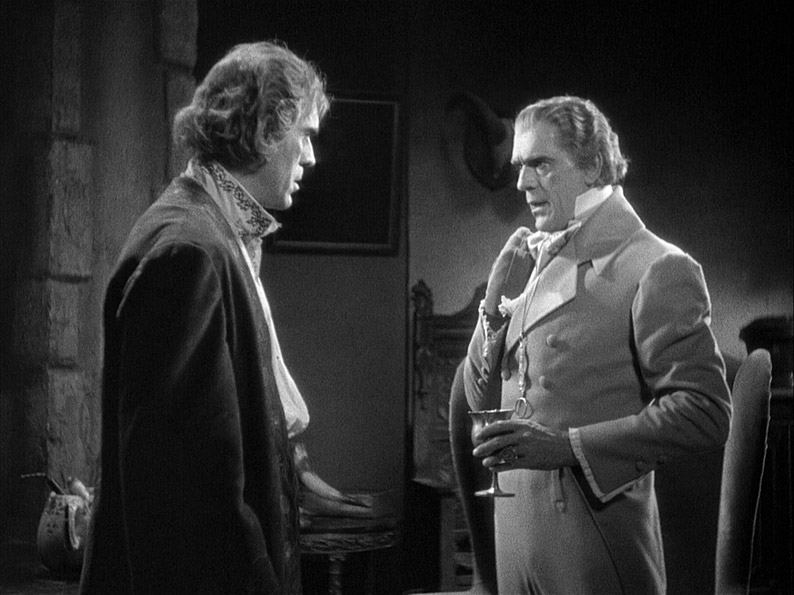
Roy William Neill directs with flair and an attention to detail that it takes a couple of viewings to fully appreciate. His expressive camera placement and the symbolic use of mirrors help to layer a story that may be peppered with gothic melodrama tropes and characters, but all are handled with such care and sincerity that they feel more like prototypes than the stereotypes they would later become. He ceratinly gets the most our of his taleneted cast, and for a film made in 1935, the split-screen work that allows Karloff to appears as both characters in the same frame is exemplary. It’s a film where everything comes together harmoniously, and is as persuasive a showcase for Karloff’s often undervalued talent as a screen actor as you’ll find in this collection.
| THE MAN THEY COULD NOT HANG |
|
Medical student Bob Roberts (Stanley Brown) is about to take one hell of a risk. He’s volunteered to become the subject of a dangerous but potentially revolutionary experiment by his mentor, Dr. Henryk Savaard (Boris Karloff) and his loyal assistant, Dr. Stoddard (Joseph De Stefani). Savaard has developed a technique for scientifically killing someone and then bringing them back to life using an external artificial heart, one he’s successfully used on animals but has yet to try on a human subject. It’s made perfectly clear that Bob has not been pressured into volunteering – he obviously believes in the technique and the possibilities for surgery that it offers and is repeatedly asked by Savaard if he is sure he wants to go ahead with the procedure. There’s just one sizeable bluebottle in the ointment in the shape of Savaard’s nurse and Bob’s devoted girlfriend, Betty Crawford (Ann Doran). Betty is against the whole thing, and when her pleas to the confident Bob fall on the deaf ears and she’s shut out of the lab, she rushes off to tell the police that her employer is killing her boyfriend. It’s no surprise that they bumble into the lab after Bob’s life functions have been shut down but before the artificial heart can be engaged. Savaard begs to be allowed just an hour to revive Bob but the cops aren’t having it and march the doctor off, unaware that he has given the key component of the artificial heart to Stoddard, who has quietly fled the scene. At Savaard’s subsequent trial for the murder of his student, an initially conflicted jury eventually finds him guilty as charged, but shortly before he is due to be executed Savaad is visited by Stoddard, to whom he agrees to donate his body…
There are a couple of plausibility holes in the otherwise enthralling first half The Man They Could Not Hang, a plot-spoiling title that makes it safe for me to get as far as I did with the story and leave you to guess what happens next. The first is the artificial heart itself, a collection of water-filled glass tubes and beakers linked by rubber tubing and whose most precious component is one that any glassware manufacturer could knock up in a couple of hours. When the machine is switched on, this dual-beaker element is rocked side-to-side by what looks like a motorised bicycle chain, and the whole thing sits on a workbench outside of the medical sarcophagus in which the subject lies. It is, as suggested in the commentary, more like an elaborate cocktail shaker than a device for oxygenating blood and pumping it around a human body. But do you know what? It doesn’t matter a jot. We’re in modern-day Frankenstein territory here, and all such equipment was required to do back in 1939 was look scientific and superficially complex and it served its purpose. It’s not a real artificial heart but a symbolic representation of a device that had yet to see the light of day, one whose glass components emphasise its delicacy and add tension to the notion that it could be broken.
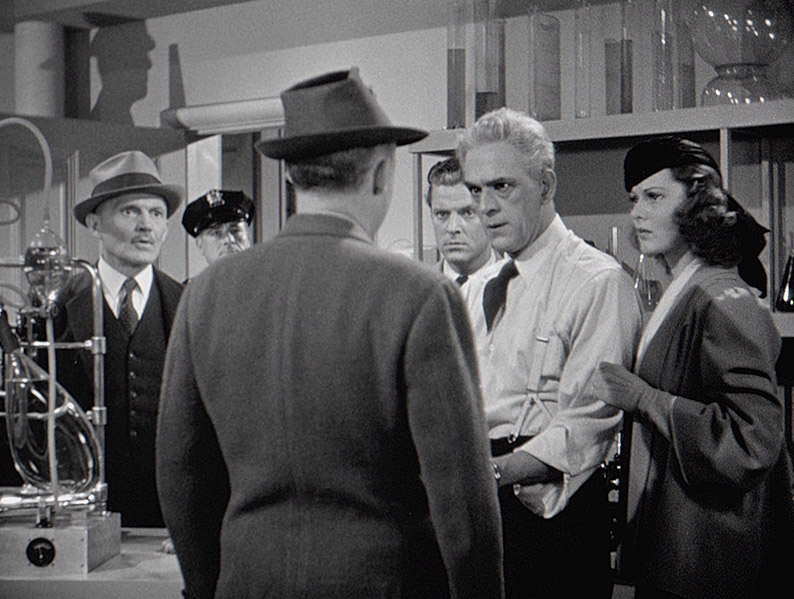
The second plausibility hiccup comes after Savaard has been found guilty and asks permission to address the court, a granted request that he uses to lambast those who have judged him, the tone of his delivery bordering on threatening. The judge does eventually cut him off, but does allow him a seriously unlikely degree of leeway before doing so. Yet the scene still serves a very real purpose, with the points Savaard makes as he walks around the courtroom being contextually valid, as he accuses the District Attorney (Roger Pryor) of murdering not just him but the countless people who could have benefitted from his discovery, and Betty of being the one really responsible for Bob’s death (and let’s face it, she is). It helps no end that he delivers this condemnation with such captivating eloquence, with Karloff making the most of a consistently smart screenplay by series regular Karl Brown.
Elsewhere, the medical aspects of the film have an unexpectedly convincing ring, and real thought has been given to how the resurrection process would have to unfold were this done for real. After Stoddard revives Savaard following his execution, for instance, I was ready for the damage done to Savaard’s body by the hangman to be handily glossed over, but Brown and director Nick Grindé had taken this on board. Savaard wakes to find himself locked in a brace that restricts all movement of his upper body and is informed by Stoddard that it took considerable effort to repair his broken neck, an affliction that Karloff works into his performance from this point on. I was also surprised to learn that the story was inspired by the true-life experiments of one Robert E. Cornish, who used a device not too far removed from the one in the film to revive two recently deceased dogs. His plan was to continue his experiments on human patients, and he even had a volunteer in the person of San Quentin Death Row inmate Thomas McMonigle, but Cornish and McMonigle’s joint petition was refused by the authorities, effectively bringing this experiment to a close. And let’s not forget that successful open-heart surgery was later made possible by a process known as cardiopulmonary bypass, in which a machine takes over the functions of the heart and lungs and keeps the patient’s blood oxygenated and moving whilst bypassing the organs normally tasked with doing the job. It’s not made of glass, but…
Karloff is again on fine form here, so kindly in the opening scene that he could probably even have talked me into becoming a subject for his experiment, but transformed into a ball of pent-up and vengeful anger in his courtroom address, only to become unsettlingly cordial when he tricks those who have wronged him into meeting at his house, where Frankenstein evolves into And Then There Were None. A solid supporting cast includes a few faces that would reappear in different role sin the following film, and include an unusually engaging juvenile lead in the shape of Robert Wilcox as investigating reporter 'Scoop' Foley, who also happens to be dating Savaard's daughter, Janet (Lorna Gray). Director Grindé does well by Brown’s dialogue, keeps the pace brisk and has quite an eye for emotive close-ups and high angle-shots. He also gives the scientific scenes a pleasingly matter-of-fact feel that adds to their odd plausibility – there’s not a note of music or word of dialogue during the sequence in which a stressed and uncertain Stoddard attempts to revive his dead colleague.
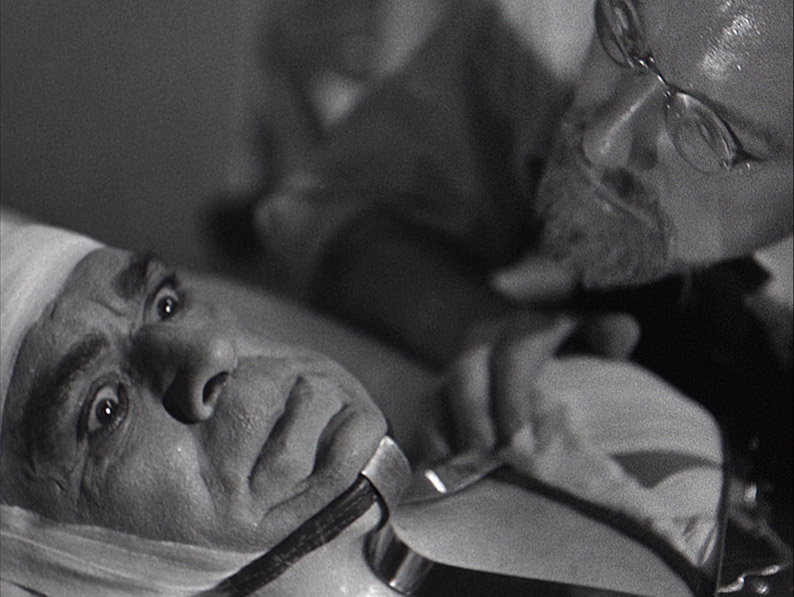
The first of Karloff’s so-called Mad Doctor films for Columbia is one of the best, for the sincerity of its performances, for Grindé’s direction, for its forward-looking science and for Karl Brown’s well-structured and literate screenplay, which is peppered with thoughtful discussions and monologues. Seriously, try this choice extract from Savaard’s courtroom response to his conviction: “You who have condemned me, I know your kind. Your forbears poisoned Socrates, burned Joan of Arc, hanged, tortured all those whose offense was to bring light into darkness. For you to condemn me in my work is a crime so shameful that the judgement of history will be against you for all the years to come!” That’s telling ‘em, doc.
If you start watching The Man with Nine Lives just after viewing The Man They Could Not Hang – at least without reading much about it first – then you might, as I did, find yourself stopping and checking that you didn’t reselect the first film by mistake. Quite aside from a title that also begins with the words ‘The Man’, it’s once again written by Karl Brown and directed by Nick Grindé, and it stars Boris Karloff as Dr. Kravaal, a name similar enough in structure to Savaard (it’s that double-a) to prompt a small double-take. It even uses the same Art Deco font for the credits.
Once again the film begins with a doctor attempting a radical new technique on a willing patient, but here the medical practitioner is Tim Mason (Roger Pryor, who played the District Attorney in the previous film) and he’s demonstrating to an audience of his peers, one of whom explains to his colleague what Mason is doing in the film’s only slice of blatant (but for a contemporary audience, necessary) exposition. Mason’s theory is that significantly – and by conventional wisdom dangerously – lowering the body temperature of a cancer patient and maintaining their life functions for a period of several days can temporarily force the cancer into remission. It’s a blend of cryogenic fact and science fiction fancy, and I have sincere doubts about one of the good doctor’s methods of raising the patient’s body temperature at the end of the procedure, which involves pouring hot coffee down a tube into the patient’s throat, which in this unconscious state is probably a direct route into the lungs.
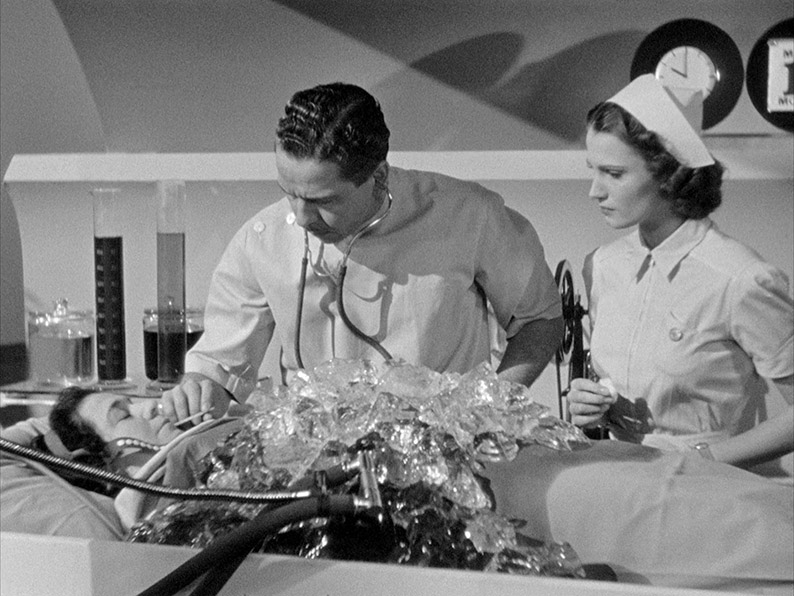
What Mason really wants to be able to do is keep a patient frozen for considerably longer, which he believes would kill the malignant cells and allow for a full recovery. After the demonstration, he reveals to his nurse and girlfriend Judith (Jo Ann Sayers) that his frozen therapy was inspired by the work of one Dr. Kravaal, who worked alone in secret at a place called Silver Lake up near the Canadian border and who apparently disappeared ten years ago. The Head of Medicine, Dr. Harvey (Charles Trowbridge), then shows up to congratulate Mason on the success of his demonstration, but also to express his concern that the press and public seem to be taking his results and running with their curative possibilities. “The day of the lone wolf experimenter is dead,” Harvey tells Mason before informing him that his frozen therapy work is to be turned over to a team of experts to check and verify his findings, which frankly doesn’t sound unreasonable given the potential risks and benefits. In order to put some distance between Mason and newspapers that are still writing headlines about this discovery, Harvey suggests that the doctor take a leave of absence. The initially crestfallen Mason admits to Judith that Harvey is probably right, but somewhat surprisingly it’s Judith who cheerily asks the crucial question, “When do we leave for Silver Lake?”
When Mason and Judith reach Silver Lake and enquire about hiring a boat in order to reach the island on which Kravaal’s long-abandoned house is located, tradition makes an appearance in the shape of a boatman who warns them against setting foot on the place. Three people went to that island ten years ago, including the local sheriff, he informs them, and none were ever seen again. Ten years ago, eh? Wasn’t that also when…? Of course, they hire a boat anyway and head straight for the island and find a house that does indeed appear to have been abandoned long ago. But when Judith falls through a rotten wooden floor into a hidden cellar – a fall that by rights should have broken something but leaves her handily unharmed – she and Mason discover Kravaal’s secret laboratory and a giant freezer room, inside which they discover the frozen body of Kravaal. After freeing Kravaal’s body from the ice, Mason uses his experimental work in cryogenics to revive him, and in doing so helps to prove the validity of Kravaal’s theories. Once up and about, however, Kravaal decides that there is one final experiment that he needs to perform.
The second in Karloff’s Mad Doctor cycle has obvious similarities to the first. This is particularly true of the processes developed by Savaard and Kravaal, both of which represent potential medical breakthroughs that are scuppered when the defining experiment is disrupted by ignorant outsiders, resulting in the death of the test patient and the arrest of the good doctor. Here, the previous film’s idiot nurse Betty is replaced by the test patient’s nephew Bob Adams (Stanley Brown, who played the unfortunate test subject in The Man They Could Not Hang), a self-interested hothead who I wanted to slap from the moment he opens his overactive mouth. A further echo of the first film comes when a band of busybodies led by Sheriff Stanton (Hal Taliaferro) encounter Kravaal’s test patient, and the irritatingly self-important Dr. Bassett (Byron Foulger, also from the previous film) pronounces him dead and dismisses the good doctor’s proclamations as hooey. All of this unfolds in flashback as a story told to Mason and Judith by the slowly recovering Kravaal, who at this point is still benevolent enough to want to unfreeze those who attempted to destroy his work so that they might also recover and go free. But when the awful Bob has a temper tantrum and does something that even I’d have punched his stupid face for doing, things take a darker turn, and Kravaal’s obsession with rediscovering a lost formula starts to overshadow his innate humanitarianism.
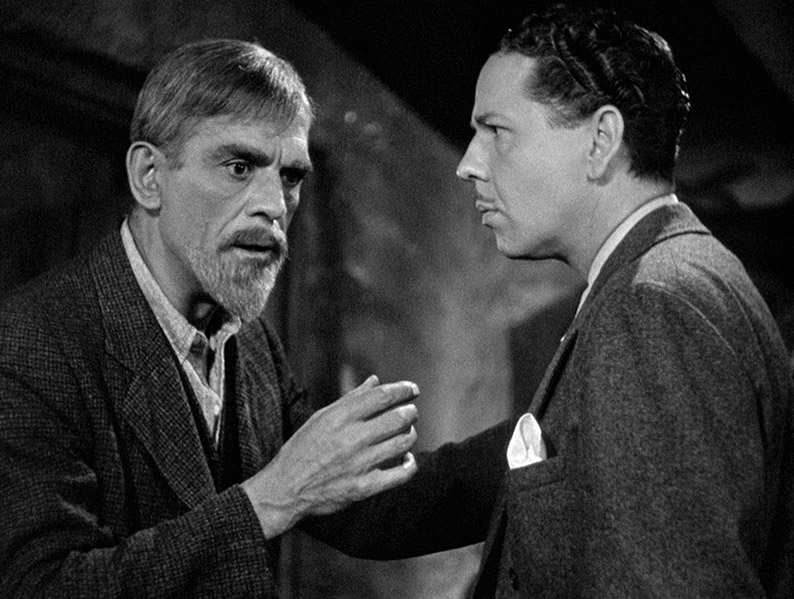
Despite the similarities to its forebear, the misleadingly titled The Man With Nine Lives (make that two) still goes its own way with its characters and its central conceit, and screenwriter Karl Brown once again furnishes the lead players with some classy dialogue and elegantly worded speeches. Although largely confined to just a few enclosed sets (and, more surprisingly, one genuine exterior location), director Nick Grindé again shows a flair for expressive camera placement, with cinematographer Benjamin Kline occasionally using depth-of-field to focus (no pun intended) our attention on a specific character. What really impressed me, however, was the ice room that Kravaal uses as a cryogenic chamber. Although designed and lit in a manner that suggests art director Lionel Banks has done a boffo job creating a convincingly fake icescape, when Mason takes an axe to start carving his way into the wall of ice the blocks the room’s entrance, he does so with real gusto and the chips that fly off look too real to have been convincingly faked. My suspicions were confirmed once the characters enter the chamber and start talking, as we can clearly see their icy breath as they speak, something that you may be able to fake with CGI nowadays but that back then could only be achieved by putting your characters in a suitably cold environment. That’s quite a commitment for what is essentially a studio programmer, and evidence of the extra mile the filmmakers were willing to go to create a work of real quality within the studio-enforced limitations of time and budget.
By this point in the series, few will be surprised to learn that Karloff once again plays a doctor who has been working on a medical procedure to extend life with a willing test subject. As this film begins, however, the experiment has failed and the patient has died, and Dr. John Garth (Karloff) is up in court charged with his mercy killing. It’s something Garth admits to doing after repeated attempts to perfect the serum that would have improved and extended the life of a man who was in indescribable pain failed. Here, there’s no talking his way out of the charge and he’s convicted and transported to prison to await his execution in a month’s time. Yet it still feels like an injustice because, even by the standard already set by the series, Dr. Garth is a model of elderly kindness and benevolence, the sort of doctor you just know would never knowingly harm a soul and who only took the life of his patient as last resort and at the man’s desperate request.
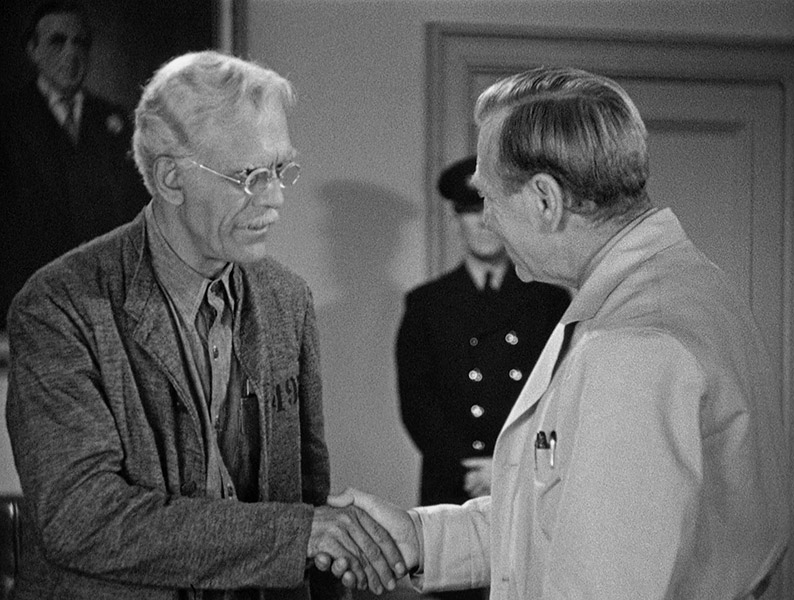
A week later, the now imprisoned Garth is brought to the office of unusually sympathetic Warden Thompson (Ben Taggart), where he is offered the chance to continue his work with prison doctor Ralph Howard (Edward Van Sloan) to develop a serum that both Thompson and Howard believe could have real benefits for mankind. Even though the execution is set to proceed in three weeks regardless of the result of his work, Garth gratefully accepts, and he and Howard work closely together and eventually have a breakthrough, one that then requires testing on a human subject to confirm. With his execution imminent, Garth asks his now trusted colleague to inject him with the serum and do a comparative blood test shortly after his death. When a last-minute reprieve commutes his execution to a life sentence, Garth has an initially bad reaction to the serum but wakes from a brief coma looking and feeling a good twenty years younger. What neither man realise at this point, however, is that the blood they extracted from a convicted murderer to make the serum is set to have a deadly effect on the as-yet unaware Garth.
At just 62 minutes, Before I Hang is, by a whisper, the shortest film in the series and has a stronger horror vibe than its predecessors, whose fantastical elements had more of a science fiction leaning. This shift in tone is especially evident once Garth and Howard begin collaborating, something they do not in a brightly lit laboratory of the sort featured in The Man They Could Not Hang but in one where darkness is punctuated only by small pools of mood-setting light. It’s here and in the later scenes when the blood in Garth’s system gives rise to homicidal urges – itself a very horror-driven notion – that cinematographer Benjamin Kline really cranks up the noir aspect of his lighting and framing to create an air of almost supernatural menace – in one splendidly symbolic use of light and dark, a killer approaches his victim, and just before he strikes his shadow plunges the unfortunate man's face into complete darkness.
Karloff is once again on impressive form here, his soft-spoken delivery coming across as the epitome of good-intentioned benevolence in the first third but taking on a more sinister leaning once the serum starts to work its dark magic. In his third run at the series, director Nick Grindé handles the early scenes with unfussy aplomb, then moves the film even further into horror-thriller territory when Garth is unexpectedly reprieved and released. After failing to convince a group of his friends to try the rejuvenating benefits of the serum, he pays one of them – pianist Victor Sordini (Pedro de Cordoba) – a visit that evening, appearing unexpectedly outside his window like a vengeful mummy, a dramatic moment emphasised by a sudden burst of music and a rapid camera track to Karloff’s face. Even more unsettling is the scene that follows, in which Garth almost pleadingly badgers the kindly Victor into agreeing to take the serum, an act of insidious coercion with discomforting real-world associations. The scene darkens further when Victor finally agrees and Garth wrestles with a rising urge to kill as he dons a pair of shiny black medical gloves, an image that would not be out of place in a later giallo thriller.
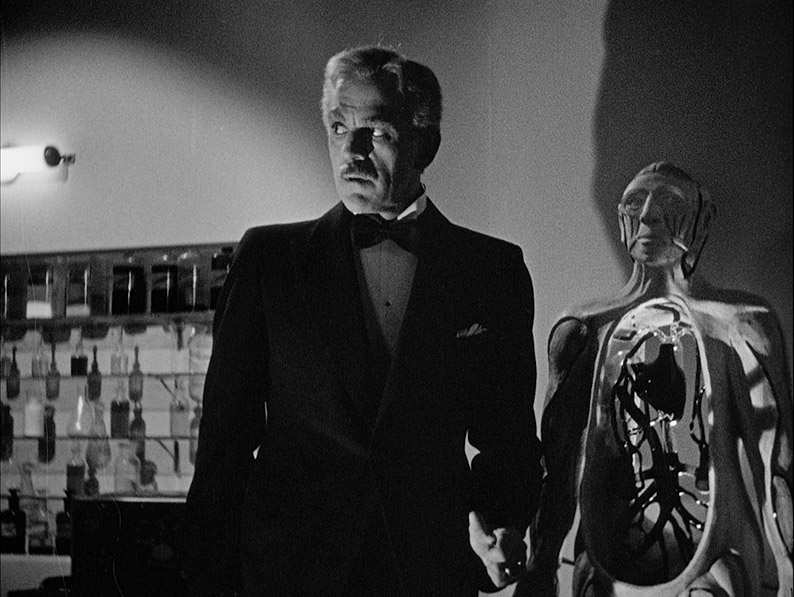
As is noted in the commentary track, Before I Hang is unusual in having the standard three-act structure stripped down to a lean two, and it’s perhaps because of this that it feels just a tad less substantial than its predecessors. It’s still a well written (by Robert D. Andrews from a story by Karl Brown), smartly directed, convincingly acted and strongly atmospheric work, one whose implausible central conceit is disarmingly easy enough to swallow within the context of the horror-thriller that the film steadily evolves into.
The ominously titled The Devil Commands begins in faux-Rebecca style, as the camera drifts towards a storm-lashed house accompanied by a reflective female voiceover. Here, however, Anne Blair (Amanda Duff) is not dreaming of returning to Manderley but pondering on why the residents of the town in which her father, Dr. Julian Blair (Boris Karloff), chose to live remain frightened by the sight of a house from which he has since vanished. Although seemingly mystified by their attitude, Anne provides a possible reason when she portentously reveals that “for one brief, terrible moment he tore open the door to whatever lives beyond the grave.” Ah, yeah, that might do it.
We then hop back seven years to happier times, when Julian is demonstrating an electrical device of his invention on his younger colleague, Dr. Richard Sayles (Richard Fiske), one that is able to read and draw a graphical representation of a person’s brainwaves, which he claims are as individual as fingerprints. When his wife Helen (Shirley Warde) shows up unexpectedly to remind him that his daughter is coming home for her twentieth birthday that very evening, Julian persuades her to also have her brainwaves measured before they leave, which she cheerfully agrees to. I was geared up for something to go horribly wrong at this point, but to my surprise it all goes well and Helen’s brainwave is drawn directly beneath Richard’s, clearly illustrating that they differ from each other.
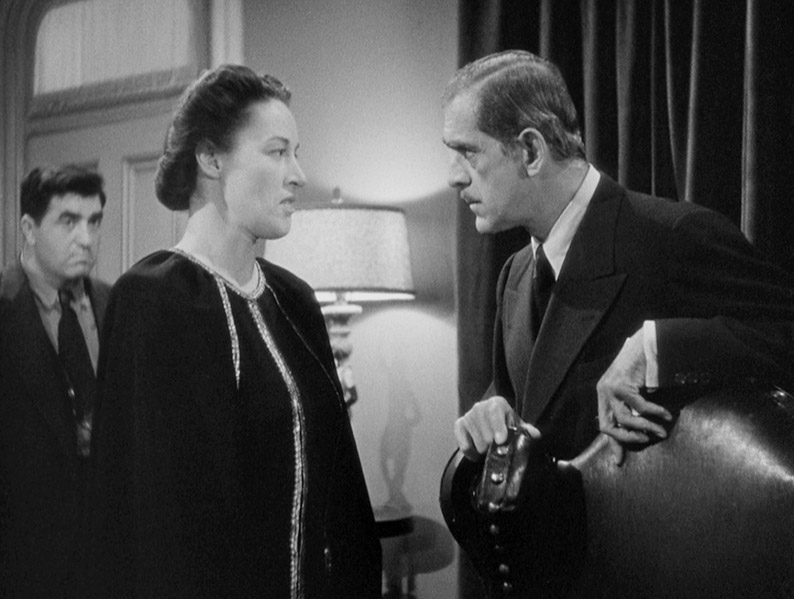
Julian and Helen then depart and head into town in shocking weather to pick up a birthday cake for Anne, but with no parking spaces available, Helen drops Julian off and drives around the block. As Julian walks out of the bakery, however, Anne skids in the rain and crashes the car, an accident in which she is immediately killed. The loss of his wife impacts deeply on Julian, and after the funeral he attempts to distract himself in his laboratory, but when he switches on the machinery, the seismographic printer kicks into life and begins plotting out Helen’s brainwave. The startled Julian becomes convinced that he has inadvertently found a way to enable the dead to talk to the living and that Helen is using it to try and contact him. His colleagues are initially incredulous, but when Julian persists, drawing persuasive comparisons to the discovery of radio waves, they become more fearful of what opening such a door to the unknown might lead to.
It’s an intriguing setup that offers a scientific take on the supernatural premise of life after death and is driven forward more by Julian’s desperation to contact his late wife than by any feelings he might have about possible benefits that the process might have for mankind. This does eventually make him as blind to reason and the wellbeing of others as his predecessors in this series, but here he will not make the journey alone. Enter Blanche Walters (Anne Revere), a spiritualist that Julian’s none-too-smart assistant Karl (Ralph Penney) visits to talk to his late mother and whose fakery Julian quickly exposes. To his complete surprise, he then discovers that she not only radiates an unusually strong amount of energy but is able to absorb it at a level that would kill and regular person. Blanche quickly becomes fascinated by the potential of the doctor’s invention –“If you can do what you’re trying to do,” she says to him, “you’ll own the world” – and agrees to work with him, to become a conduit through which he can hopefully contact his wife. When they add Karl to the circuit to boost its power, however, he unable to take voltage levels that leave Blanche unharmed, and is left brain-damaged by the procedure. Julian is shaken but the icily cool Blanche quickly takes charge and suggests they sell up and move away in order to continue the experiments in secret, taking the now mute and almost robotic Karl with them. They settle in an old house on the New England coast and spend the next few years developing the process in secret, but over time they become the target of suspicion and eventual hatred by members of the local community, none of whom have any idea what is unfolding within the walls of this clifftop abode.
Although technically still a work of science fiction, The Devil Commands moves the Mad Doctor series closer to the realms of horror than any of its predecessors, and is certainly the only one that openly flirts with the supernatural. This is really ramped up when Julian, Blanche and Karl move to New England and their house becomes a troubling temple of dark shadows and sinister secrets. Having enthusiastically demonstrated his work to his colleagues at the start of the film, Julian’s laboratory is now closed to all visitors, us included, while Julian himself has visibly aged and appears to be very much under the thumb of the coldly commanding Blanche. Any attempt to investigate is met first with polite resistance from housemaid Mrs. Marcy (Dorothy Adams), then by the intimidating presence of the silent but bulky Karl. Driven as he is by the disappearance of several bodies since Julian moved into the area, local sheriff Ed Willis (Kenneth MacDonald) is not so easily dissuaded. When he convinces Mrs. Marcy to sneak into the laboratory and find what the doctor has been up to, what she discovers is an extraordinary melding of science fiction and gothic horror, one so dark in its implications that all footage of it was apparently cut from film on its UK release, which I imagine must have transformed the film’s final scenes into a confusing mess.
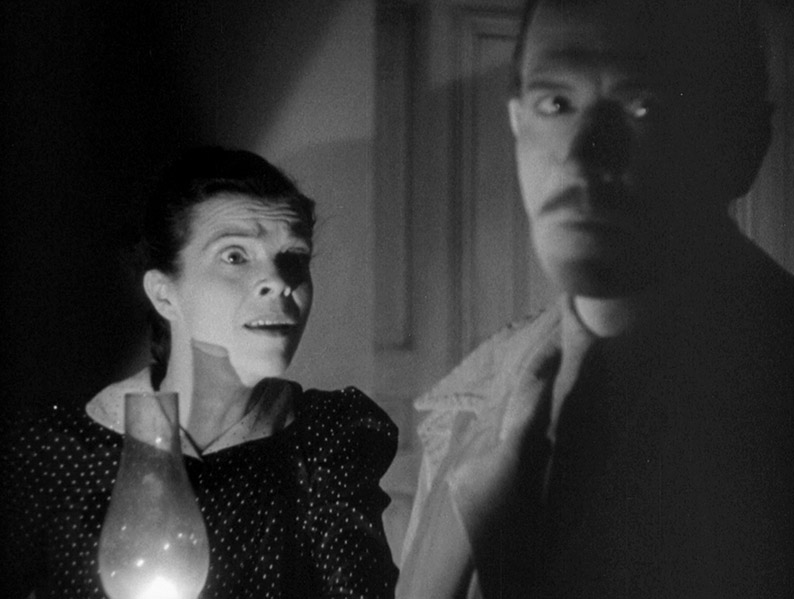
Murder, My Sweet director Edward Dmytryk works with veteran cinematographer Allen G. Siegler to really crank up the spookiness of the house interior in the film’s later stages, while the scenes involving the New England laboratory are as creepy as anything I’ve sat wide-eyed through all year. Karloff is once again on solid form, and while Amanda Duff and Richard Fiske don’t exactly set the screen alight as nominal juvenile leads Anne and Richard, much of the supporting cast is top notch. Notable on this score are Kenneth MacDonald as unusually calm and level-headed sheriff Ed Willis, and Dorothy Adams as housemaid Mrs. Marcy, but quietly stealing every scene she appears in is Anne Revere as fake medium Blanche Walters. She’s genuinely fascinating to watch, from her buttoned-down hostility towards Julian as he exposes her tricks to the small and contempt-driven movement of her arm that dismisses the doctor’s helping hand following the first test of her abilities. When Karl collapses under the force of the electrical charge that’s been pumped into his body, it’s Blanche who takes immediate control of the situation, giving orders to Julian and making plans for their immediate future.
On the commentary track, Stephen Jones and Kim Newman make a case for why The Devil Commands is their favourite of the Mad Doctor films, and I’m absolutely with them on this. Coming to the film as an adult with decades of genre movies under my belt I enjoyed it immensely for its atmosphere, its performances, the possibilities of its central premise and its seamless melding of science fiction with gothic horror. Had I seen it as a kid still discovering the dark delights of the horror genre, I have absolutely no doubt that there are scenes in the second half that would have scared the living crap out of me.
| THE BOOGIE MAN WILL GET YOU |
|
Right from the start, it’s made clear that this fifth and final film in the Mad Doctor cycle is going to be playing the whole concept for laughs, something loudly signalled during the opening titles by the jaunty and comically toned main theme and its pratfall penny whistles. The setup certainly has a familiar ring, taking inspiration not just from the previous films in the series but a couple of notable stage hits of the day that were also in the process of being adapted for the big screen. I’ll get into this in more detail in a minute.
The entire film is set inside and just occasionally outside a former 18th century tavern that is now the run-down home of Professor Nathaniel Billings (Boris Karloff), who is looking for a quick sale to pay off his mortgage debt. He spends his time conducting experiments in the cellar on travelling salesman, all of whom have so far died, sometimes due to oversights on his part. His housekeeper, Amelia (Maude Eburne), is obsessed with providing a home for chickens she has yet to buy, while grouchy groundsman Ebenezer (George McKay) appears to live in the barn with his pigs. Things look up for Nathaniel when chirpily cheerful Winnie Slade (Jeff Donnell) knocks on his door and seems immediately keen to buy this historically significant property, delighting in its flaws and agreeing to let Nathaniel stay until he concludes his experiments. With the sale agreed, despite loud objections from Winnie’s ex-husband, Bill Layden (Larry Parks), an overjoyed Nathaniel contacts his mortgage lender, Dr. Arthur Lorencz (Peter Lorre), to call him to the house and finally cancel his debt. As he is doing so, Winnie’s plan to turn the building into a hotel gets off to an unexpectedly flying start when stuffy-nosed choreographer J. Gilbert Brampton (Don Beddoe) rolls up looking for a room for a couple of nights.
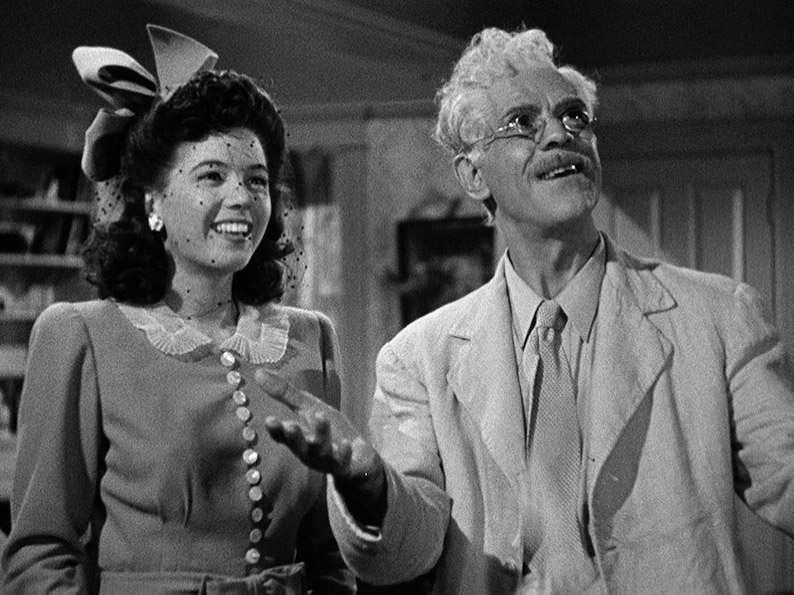
Of course, we’re just getting started here, and things quickly complicate when Bill finds the body of Nathaniel’s latest victim in the basement and he and Winnie run into town to alert Dr. Lorencz, who is also the town’s sheriff, mayor, coroner, notary and justice of the peace. When Lorencz confronts Nathaniel in the cellar, however, the professor explains his plan to turn a man into a superman, and instead of arresting him Lorencz expresses his keenness to help. Brampton, meanwhile, is repeatedly found behaving oddly in places he has no business being, and Bill’s frustration at the disappearance of the body that Lorenz has secretly helped to conceal but claims to never have seen makes him determined to get to the bottom of whatever is going on in the madhouse his ex-wife has purchased.
Those familiar with the influences will likely recognise the plot borrowings from Moss Hart and George S. Kaufman’s George Washington Slept Here and Joseph Kesselring’s Arsenic and Old Lace, two popular stage plays of the day that were still in the process of being turned into movies when The Boogie Man Will Get You hit cinemas. The influence of Arsenic and Old Lace is most keenly felt, in the rapid pacing, the quickfire dialogue, the black comedy, the eccentricity of the characters, the dark secret in the cellar, and the fact that that Karloff had a key role in the stage production, playing a part that was specifically written for him. Indeed, he was only able to make this film at all because due to an agreed hiatus – ironically, when Frank Capra’s film adaptation of Arsenic and Old Lace went into production, Karloff’s commitment to the stage play prevented him for reprising his role for the screen, which effectively nobbled the gags made at his expense. In a further piece of irony, the contract struck with the play’s producers delayed the release of the film for over a year until the Broadway run of the play ended (the play proved to be a bigger hit than anticipated and ran for three-and-a-half years), and shooting thus could possibly have been rescheduled to accommodate Karloff’s stage commitments after all.
It’s the similarities to Arsenic and Old Lace in particular that have seen The Boogie Man Will Get You damned with faint praise or dismissed as a comparatively limp and comedically anaemic work, unsurprising given the high esteem in which Capra’s movie is held. But as someone who laughed himself silly on his first viewing of Arsenic and Old Lace and still gets the giggles every time Cary Grant does one of his spectacular double-takes, I still enjoyed the hell out of The Boogie Man Will Get You and am happy to offer a hearty shout in its support. The cast is a key draw here, with Karloff clearly having fun playing a befuddled old professor who for once isn’t transformed midway through the story into the film’s villain, and he is perfectly matched with a wonderfully funny Lorre in what would prove to be the second of four comedy films in which the two actors are paired.* Jeff Donnell (credited on the film as “Miss Jeff Donnell” to clarify her gender for those confused by her first name) and Larry Parks really throw themselves into the roles of Winnie and Bill, with Parks displaying a real talent for physical comedy, particularly in a sequence that had me laughing out loud when he attempts to bed down for the night on a mattress so saggy it almost touches the floor.
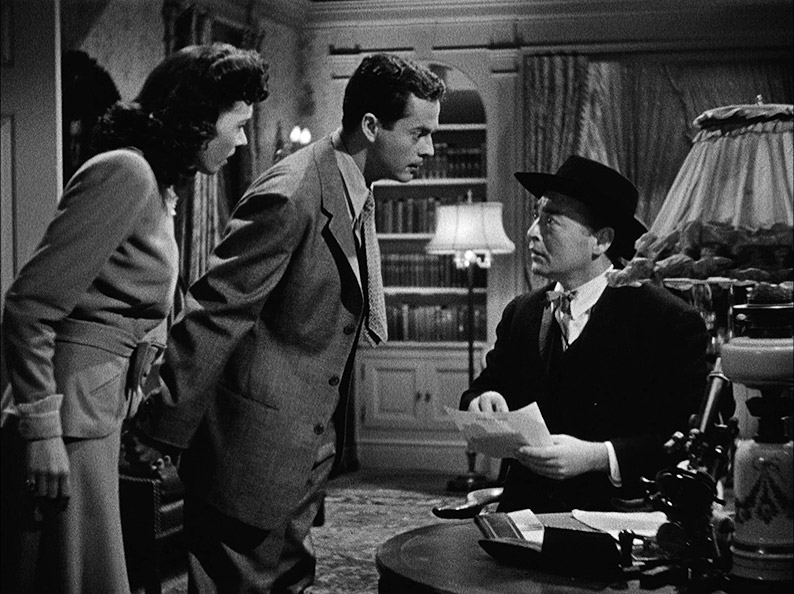
The screenplay by Edwin Blum (with Paul Gangelin credited for the adaptation) may have poached ideas aplenty from the aforementioned plays but is still peppered with amusing dialogue and the occasional line that borders on the bizarre. A personal favourite occurs when Brampton first arrives and asks Bill if he has any rooms, to which the bemused Bill replies, “A what?” which prompts the peculiar response, “I did not ask for a sylvan dell replete with prancing antelopes, merely a room.” There’s an amusing response from Nathaniel when Lorencz attempts talk up the shark-oil hair restorer on which he apparently made his fortune – “Where is the hair follicle that can resist two thousand international units of vitamin A?” he proclaims, which prompts Nathaniel to bend forward and point at the back of his scalp with the accusation, “Right there!” The gags come thick and fast and vary widely in style (and, some will say, quality), from the slapstick to the verbal and even to the surreal, the oddest of which involves a Siamese kitten that Lorencz carries in his jacket pocket and takes out intermittently to converse with in German like a substitute partner that he can’t bear to part with.
There’s no question that The Boogie Man Will Get You is daft as a brush and that it borrows heavily from plays that were made into highly accomplished and genuinely funny films, and if watched on a double bill with either would almost definitely come across as the lesser work. But seen in isolation and on its own merits, I thought it a whole barrel of fun, for the delightful interplay between Karloff and Lorre, for Donnell’s enthusiastic chirpiness and Parks’ way with outrage and physical comedy, for Blum’s quickfire script and Lew Landers’ brisk direction, and for the filmmakers’ collective willingness to throw just about anything into the mix and see what hits the target. It’s often described as a horror-comedy but I’m not sure it was ever intended as such and is more a comedy that riffs on the tropes and characters of the previous Mad Doctor films. In that respect is a perfect sign-off for the series.
I’ve not been able to confirm the details of the transfers featured on this two-disc Blu-ray, but it’s clear that there has been some restoration work carried out here, though it isn’t consistent across the six titles.
It may come as a surprise that the best looking of all is the oldest of the six, The Black Room, which looks rather lovely here, with a rich tonal range, solid black levels, crisp rendition of detail and almost no trace of dust or former damage. All are framed in their original aspect ratio of 1.33:1.
The Man They Could Not Hang also looks good, though the image is not quite as eye-catching as the transfer on The Black Room, with very slightly softer image detail and a less luminous tonal range. The black levels are solid and dust spot have largely been cleaned up, but there are two occasions when a collection of small blips appear on screen and hang around for a few seconds.
The Man with Nine Lives is also in very good shape with a similar level of image detail and deep black levels that contribute nicely to the atmosphere once the action moves underground. There are very few dust spots, but ten minutes before the end there is a considerable drop in quality, which suggests that this final section of the film was missing from the print or negative from which the restoration was made and had to be sourced instead from a lower quality print.
Before I Hang is on a par with The Man They Could Not Hang and may even have a whisper of an edge on it, though the sharpness is still not quite up to the standard set by The Black Room. The black levels are solid and the print is once again largely clean of damage and dust, though a few small scratches are occasionally visible.
Disappointingly, the best film of the set also has the weakest image quality, as while The Devil Commands is in largely good shape, there are still a fair few dust spots in places and some very visible scratch damage on the left of the screen at one point that hang around for a minute or two. The sharpness is not quite as crisp as that of the other films in this set, and while the black levels are once again rock solid, they do tend to pull in some of the surrounding detail.
Finally, The Boogie Man Will Get You is of similar quality to The Man with Nine Lives, but without the drop in quality that marked the last ten minutes of that transfer. Along with the other five films in this set, there is a fine but visible film grain and the image sits solidly in frame with no jitter or damage-triggered jumps.
All six films have Linear PCM 2.0 mono soundtracks, and while they show their age in the inevitably narrow dynamic range, dialogue is always clear and sometimes surprisingly bright, and there’s very little in the way of background hiss or fluff. I didn’t spot any major instances of damage or wear.
All six titles have optional English subtitles for the deaf and hearing impaired.
Each of the films has a busy and informative commentary track, the duties on which have been evenly divided between two pairs of well-known experts in the field of horror and fantasy film. The first consists of English Gothic: A Century of Horror Cinema author Jonathan Rigby and The Encyclopaedia of Fantastic Film and Television editor Kevin Lyons, while the second features the horror commentary dream team of genre writers Stephen Jones and Kim Newman. I’ll save space and state up front that all six commentaries are essential and information-packed companions to the films, and the enthusiasm the commentators have for (most of) the titles is genuinely infectious. The Jones and Newman ones in particular have a wonderfully lively fan-boy vibrance that makes you feel almost as if you are in the same room and part of a discussion that you’d join if you could just get a word in edgeways.
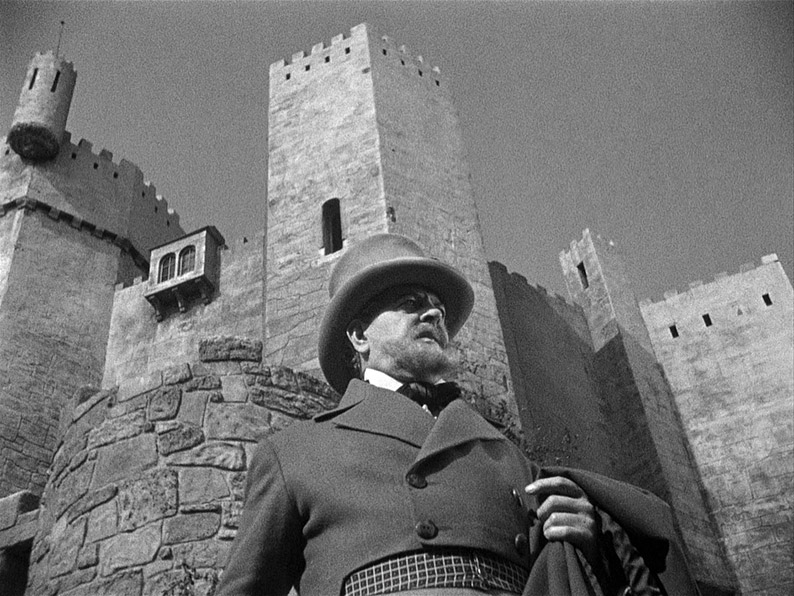
Audio Commentary on The Black Room by Jonathan Rigby and Kevin Lyons
Right from the start, Lyons and Rigby note how gorgeous this film looks and go on to discuss the actors, the use of twins in horror movies, Karloff’s dual performance, the use of mirrors and mirroring in the characters and action, the level of detail in the set design, director Roy William Neil, how a rise in horror film production led to a backlash from the British censors, and much more. They also make the intriguing observation that Jeremy Irons is now a dead ringer (pun intended) for Boris Karloff and suggest that if a biographical film about Karloff’s life is ever made, he should be the casting director’s first choice.
Audio Commentary on The Man They Could Not Hang by Stephen Jones and Kim Newman
In their first commentary in this set Jones and Newman express their admiration for the opening titles, note that Karloff seems to be enjoying himself here and that his performance in the film is often underrated, then go on to provide details on a many aspects of the film and those involved in its making. Areas covered include the gothic science fiction films of the period, the dip in production and revival of the horror genre, the screenwriters, the actors, the director, the real-life experiments of Robert Cornish, the scientific equipment, and a whole lot more. They comment on the over-complicated nature and reliance on chance of Savaard’s second-half plot to kill his enemies, but also suggest that it could have been taken further. “Unusually for a film of this period,” says Newman, “I could do with another ten minutes and another three deaths.”
Audio Commentary on The Man With Nine Lives by Stephen Jones and Kim Newman
Jones and Newman are back for the second of the Mad Doctor films to discuss how scientists tended to be portrayed in films in the 1930s, the claustrophobic settings in which much of the film takes place, how the film’s viewpoint shifts from Mason to Kravaal once the latter is found, the film’s insanely brief production schedule, the reappearance of actors from the previous film, and plenty more. They do comment on the use of what looks like a cold room set but are unable to provide any further detail on this. They usefully explain for those who do not know where the tradition of moving bodies of characters after they die comes from, and reveal that the film was cut by six minutes for its UK release but that we’re watching the full uncut version here.
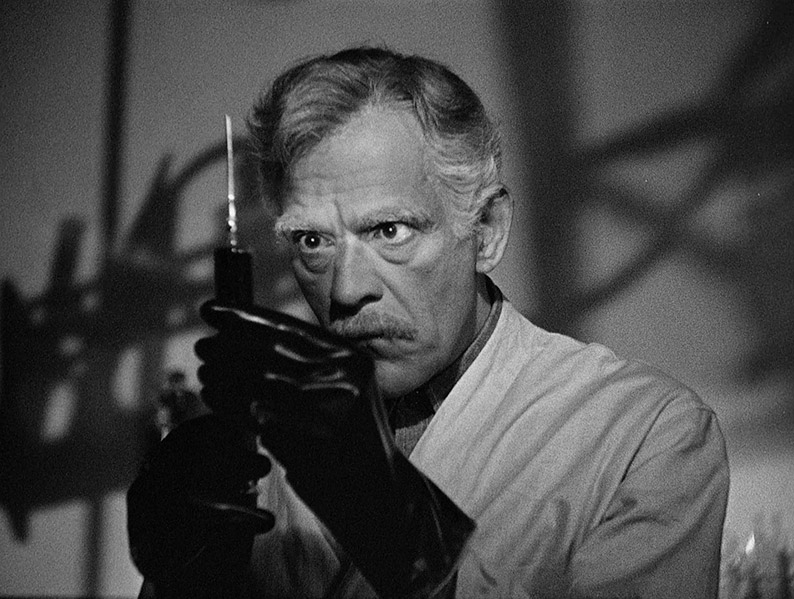
Commentary on Before I Hang with Kevin Lyons and Jonathan Rigby
Lyons and Rigby return to the commentators’ chairs to look at how this film teeters between real science and fictional mad science, at the career and work of screenwriter Karl Brown and actor Edward Van Sloan, at the film’s unusual two-act structure, at the rumours of a longer 71-minute cut, at the source of the idea that the blood of a murderer could affect the behaviour of its recipient, at other mad scientists in films of the period, and more. They also suggest that one particular line delivered by Garth to the warden – “The kind of scientist who has no room for faith in his universe is rather old-fashioned these days” – was likely a sop to “certain audiences of the day.” Given that the opposite tend to be true, I’m absolutely with them on this.
Audio Commentary on The Devil Commands by Stephen Jones and Kim Newman
For their final commentary in this set, Jones and Newman look at the literary sources of much of early American cinematic horror, the career of director Edward Dmytryk and his dealings with the House of Un-American Activities Committee, the ways in which the film differs from its source novel, the absence of any religious references in a film that deals with a possible afterlife, and why this is their favourite film in the series. There’s more information on Karloff, a discussion about scenes that play as if material is missing, praise for a strong supporting cast, the suggestion that the film feels almost like an episode of The Outer Limits, and enthusiastic agreement that Anne Revere effectively steals the film. Another splendid commentary, crammed with information.
Commentary on The Boogie Man Will Get You by Kevin Lyons and Jonathan Rigby
The final commentary in the set falls to Lyons and Rigby, who once again are bristling with information on the film and those involved in its making, though I did get the feeling that they drew the short straw and ended up having to comment on a film they’re not that big fans of. They certainly get a bit sniffy when talking about some aspects of comedy that I really enjoyed, but in other respects they still deliver the goods, with details on the influence of George Washington Slept Here and Arsenic and Old Lace, the actors, screenwriter Edwin Blum, the difficulty of balancing horror and comedy, director Lew Landers (about whom surprisingly little is known), and more.
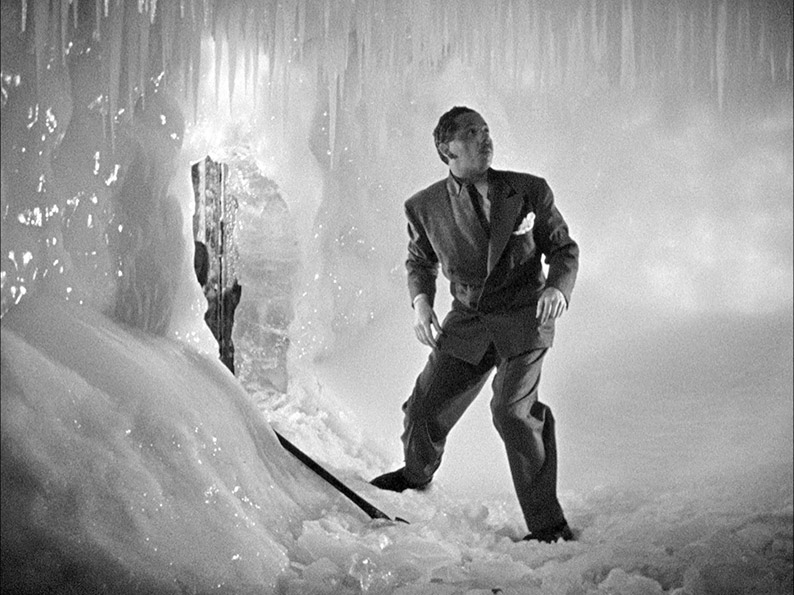
Karloff on the Radio
Spread across the two discs in this set are four episodes of the long-running mystery and suspense radio series, Inner Sanctum Mystery, each of which starred Boris Karloff in the lead.
The Corridor of Doom (29:15)
First broadcast on 23 October 1945, this one stars Karloff as a man who wakes in an unfamiliar hospital, bandaged from an unspecified operation, and finds himself travelling down a terrifying corridor every time he is sedated, one lined with doors sporting the names of people who have died. Built around the man’s internal monologue, which really showcases Karloff’s lovely voice and delivery, and just when you think you know how it will end there’s a final and nicely handled twist to the tale. The episodes at this stage of the series were sponsored by Lipton’s Tea and the expected and comically toned interruptions to promote it are there, And the mockingly sardonic “Mr. Host” dates the broadcast rather awkwardly be revealing that next week’s episode is about “two women who like to be treated rough – choke ‘em to death, shoot ‘em, murder ‘em, they love you for it.” Oh, do you bloody think so?
The Wailing Wall (29:18)
The ghosts of Edgar Allen Poe’s The Black Cat and The Tell-Tale Heart hover in the background of this splendidly creepy and vividly performed story of a man (played by Karloff) who murders his wife and walls her up in his house, then is haunted by an unearthly wailing from within this improvised tomb. Things complicate when the police find a body in the river and when the man’s girlfriend stumbles on to what she thinks he’s done. First broadcast on 6 November 1945, this one’s also encased in promotions for Lipton’s Tea, and the host does it again with his archaically sexist parting thought, “Don’t seal your wife in a wall – that won’t keep her quiet.” This guy needs a smack.
Birdsong for a Murderer (21:40)
Here Karloff plays Carl Warner, a man with an unhappy past who has now found contentment with a young wife and a collection of pet canaries, whose singing he finds uplifting. Then one night he is visited by a man who used to work at the local asylum and who is now out of work and in need of money. The man recalls that just before he lost his job, a homicidal maniac with a love of canaries escaped, and he’s noticed that Warner appears to be doing rather well for himself… First broadcast on 22 June 1952, by when Lipton’s Tea was thankfully no longer a sponsor, though the sardonic Host is still with us and he misses no opportunity to make bad wordplay jokes.
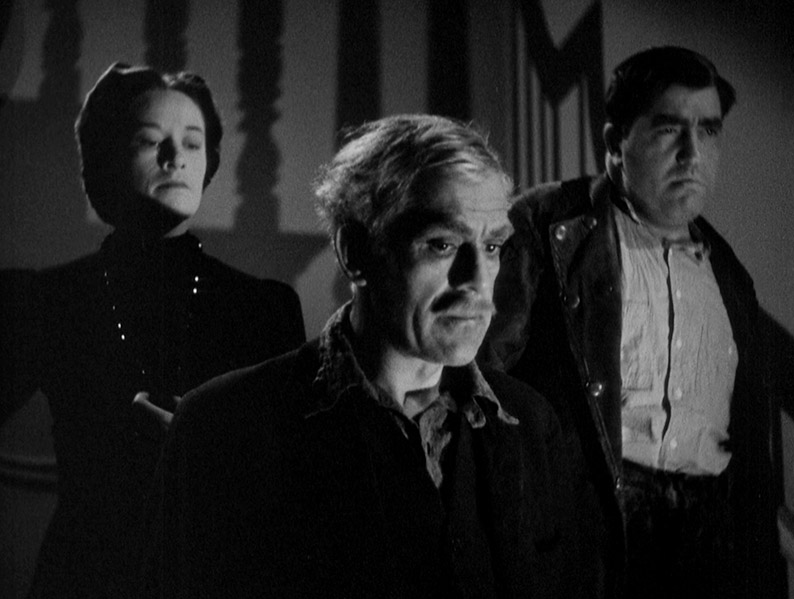
Death for Sale (24:51)
In the fourth and final broadcast in this set, which originally went out on 13 July 1952, Karloff plays Mark Devers, who seven years earlier concocted a scheme with his girlfriend Cora to make $50,000 by paying a man named Elliot Stans to marry Cora and then fake his own death, which would enable them to eventually collect the insurance policy they had taken out on his life. With just a few days to go until the money becomes theirs, however, Elliot reappears demanding that they pay him another $5,000 to stay technically dead, something Mark decides to take a drastic step to put a stop to. Once again, the Host makes a string of wincingly painful word puns, but at least manages to avoid any derogatory comments about women.
Image Galleries
Each film is also accompanied by two image galleries, one titled Production Stills, the other titled Artwork and Ephemera, in which you'll find posters and other press materials. The quality of the scans in all galleries is very high.
Booklet
Following the main credits for all six films, this handsomely presented and illustrated 48-page booklet opens with a wonderfully in-depth essay on Karloff and The Black Room by film writer and author of Boris Karloff: More Than A Monster, Stephen Jacobs. This is followed by a shorter but still compelling piece on the same film by film scholar, writer and researcher, Craig Ian Mann. Stephen Jacobs is back next for a look at Karloff’s other work at Columbia and takes a detailed look at each of the five Mad Doctor films and includes several quotes from Karloff and a few from colleagues on the series. After this, we have a second and equally detailed exploration of Karloff’s Columbia films by film critic and author Jon Towlson, whose take on the films is distinctive and interesting enough for it to be nicely complimentary to the preceding piece from Jacobs. The usual viewing notes and Blu-ray credits round things off.
You could almost be forgiven for thinking that this Karloff at Columbia set was a new Indicator title, given the number of Columbia box sets they’ve released (Columbia Noir #3 is out later this month), but it’s Eureka we must thank for what really is a lovely collection of undervalued films that handsomely showcase the too-often unsung acting talents of their star. Although there is some variance in the quality of the transfers, the best material looks terrific for films of this vintage, and each one is accompanied by a superb commentary from renowned and enthusiastic experts in their field. As a bonus we also have four episodes of the long-running Inner Sanctum Mystery radio show, all of which also feature Karloff in the lead, plus a series of excellent essays on the films. I love this release. Very highly recommended.
|